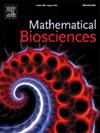Modeling cholera transmission dynamics with antibiotic resistance and mutation: A case study in Zimbabwe
IF 1.8
4区 数学
Q2 BIOLOGY
引用次数: 0
Abstract
Cholera remains a significant cause of morbidity and mortality worldwide. Although antibiotic use can reduce transmission, misuse, overuse, or incomplete treatment can foster the emergence of antibiotic resistance. Selective pressure plays a crucial role in shaping the dynamics of resistance in , particularly by increasing the mutation rate that transforms antibiotic-sensitive strains into resistant ones. In this study, we develop a novel mathematical model to investigate the impact of antibiotic resistance on cholera transmission dynamics. We establish the existence and stability of equilibria and fit the model to cholera outbreak data from Zimbabwe. Our results reveal a critical interplay between mutation rates and strain fitness: when resistant strains have low reproductive fitness, increased mutation rates alone fail to establish their dominance; however, when resistance carries a fitness advantage, higher mutation rates trigger a regime shift to resistant strain dominance—a newly identified phenomenon with implications for resistance management. We further demonstrate that incomplete treatment (lower recovery rates) exacerbates resistance by prolonging antibiotic exposure. Crucially, our findings underscore that judicious antibiotic use can simultaneously curb resistance emergence and outbreak spread in Zimbabwe, offering actionable insights for public health strategies.
模拟霍乱传播动力学与抗生素耐药性和突变:在津巴布韦的一个案例研究
霍乱仍然是全世界发病率和死亡率的一个重要原因。虽然使用抗生素可减少传播,但滥用、过度使用或治疗不完全可促进抗生素耐药性的出现。选择压力在形成霍乱弧菌耐药动态方面起着至关重要的作用,特别是通过增加将抗生素敏感菌株转变为耐药菌株的突变率。在这项研究中,我们开发了一个新的数学模型来研究抗生素耐药性对霍乱传播动力学的影响。我们建立了均衡的存在性和稳定性,并将模型拟合到津巴布韦的霍乱暴发数据中。我们的研究结果揭示了突变率和菌株适应度之间的关键相互作用:当抗性菌株的生殖适应度较低时,单独增加突变率无法建立其优势地位;然而,当抗性具有适应性优势时,较高的突变率会引发抗性品系的统治性转变——这是一种新发现的现象,对抗性管理具有启示意义。我们进一步证明不完全治疗(较低的恢复率)通过延长抗生素暴露加剧了耐药性。至关重要的是,我们的研究结果强调,明智地使用抗生素可以同时遏制津巴布韦耐药性的出现和疫情蔓延,为公共卫生战略提供可行的见解。
本文章由计算机程序翻译,如有差异,请以英文原文为准。
求助全文
约1分钟内获得全文
求助全文
来源期刊

Mathematical Biosciences
生物-生物学
CiteScore
7.50
自引率
2.30%
发文量
67
审稿时长
18 days
期刊介绍:
Mathematical Biosciences publishes work providing new concepts or new understanding of biological systems using mathematical models, or methodological articles likely to find application to multiple biological systems. Papers are expected to present a major research finding of broad significance for the biological sciences, or mathematical biology. Mathematical Biosciences welcomes original research articles, letters, reviews and perspectives.
 求助内容:
求助内容: 应助结果提醒方式:
应助结果提醒方式:


